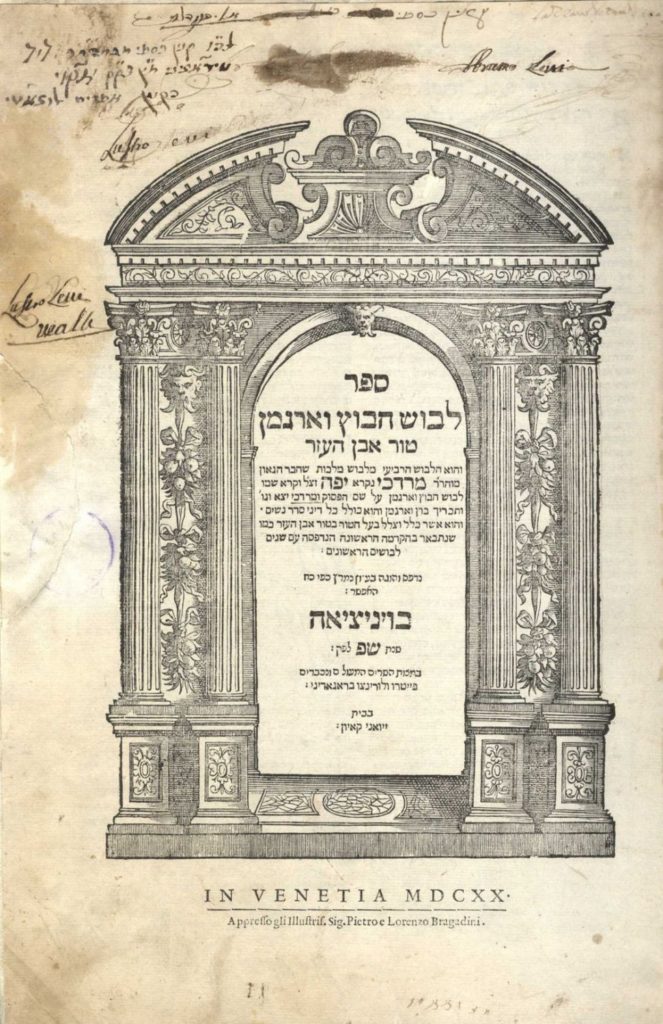
Sefer HaLevush HaButz V’Ha’argman. Venice 1620-1621, with tens of glosses written by kabbalist, Rabbi Shmuel Vital; The glosses were never printed.
Specifications : [87] leaves, paper. 35×24 cm. [74] glosses handwritten by the Maharsh”u, in Sephardic handwriting. [40] glosses are lengthy and [30] are short. Some of the glosses begin with the letters א”ש [initials for “Amar Shmuel” – “Shmuel says”]. In addition, Rabbi Shmuel manually corrected errors and added [19] subjects to the index at the end of the work.
Unique features: Rabbi Shmuel had a special appreciation for the “Levush”, noting, “my soul yearns for it very much,” and he wrote his novellae and comments on it. Some of these comments were first published in the Petach HaDvir , but only on Orach Chaim. This work discloses his complete, original comments on Even HaEzer, and includes tens of glosses that were never printed.
Background: Kabbalist Rabbi Shmuel Vital, Maharsh”u (1598-1677) , was the son of Rabbi Chaim Vital, the primary and very precise recorder of the Torah of the Arizal. He was the son-in-law of Rabbi Yeshayahu Pinto [Haria”f], and his father testified that he stemmed from the root of the soul of the Arizal. He served as Rabbi and Rosh Yeshiva in Damascus, where he taught the Torah of the Arizal. When he moved to Egypt in 1663, he shipped his belongings – including his books and manuscripts – before him, and some were lost or stolen during the journey. He wrote: “Due to my sins, when I was expelled from my homeland, my home, city and country, and was a sojourner in a foreign land…I was robbed a number of times of money and books…”
He edited his father’s works, including the Shemona Shearim , the first official work of the Arizal’s kabbala. His disciples, Rabbi Yaakov Tzemach and Rabbi Meir Poppers continued his work. His known works include: Totzaot Chaim on the Torah; Shu”t Be’er Mayim Chaim, Mekor Chaim – sermons; Chachmat Nashim – regarding the laws of Gittin, Yibum and Chalitza; Chaim Shnayim Yishalem – novellae on the Talmud and halacha; and more.
His biography is included in Beer Mayim Chaim , published by Rabbi Aharon Wieder Fishel Hershkowitz, 1966, p. 287-302.
Condition: Antiquated, detached and blemished binding with stains and worming holes. Moderate-fine condition.
This lot includes an expert analysis of the work, decisively confirming that the glosses were written in the hand of Rabbi Shmuel Vital.
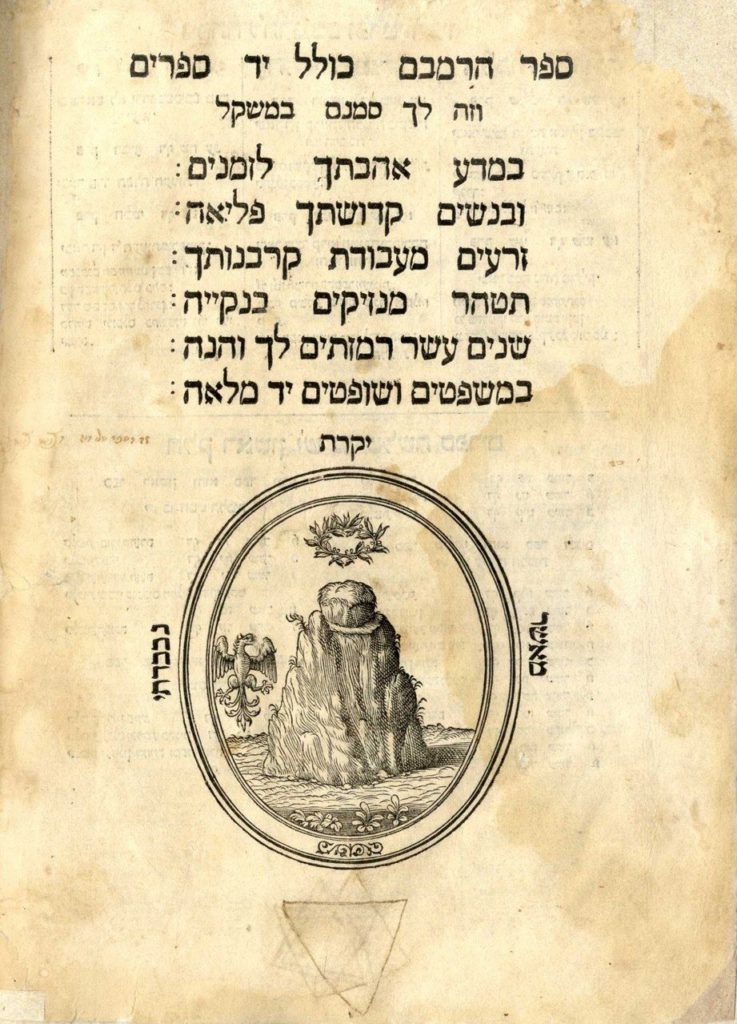
Mishneh Torah L’Rambam with the Hasagot HaRava”d, Magish Mishneh and the Kesef Mishneh commentary of Rabbi Yosef Karo. Venice, [1574]. With hundreds of handwritten glosses.
Specifications: Volume one: Sefer Mada, Ahava and Zemanim. [21] 306 leaves [missing the title page and ten concluding leaves], about 28 cm.
Unique features: There are hundreds of handwritten glosses throughout the book. The glosses were written by a number of writers soon after the book was printed, at the end of the 16th and beginning of the 17th centuries. The many glosses include text variations, some references, and lengthy scholarly comments. The text of this edition of the Rambam is considered particularly well proofread, and it seems that the writer compared the text in this edition to another version that he had.
One gloss notes that the book had been in the beit medrash of Rabbi Eliyahu Shmama, in other words, in Damascus or Aleppo. The glosses have only been inspected superficially.
Condition: Fine. Most of the comments and glosses are legible and clear. Aging stains. Not bound.
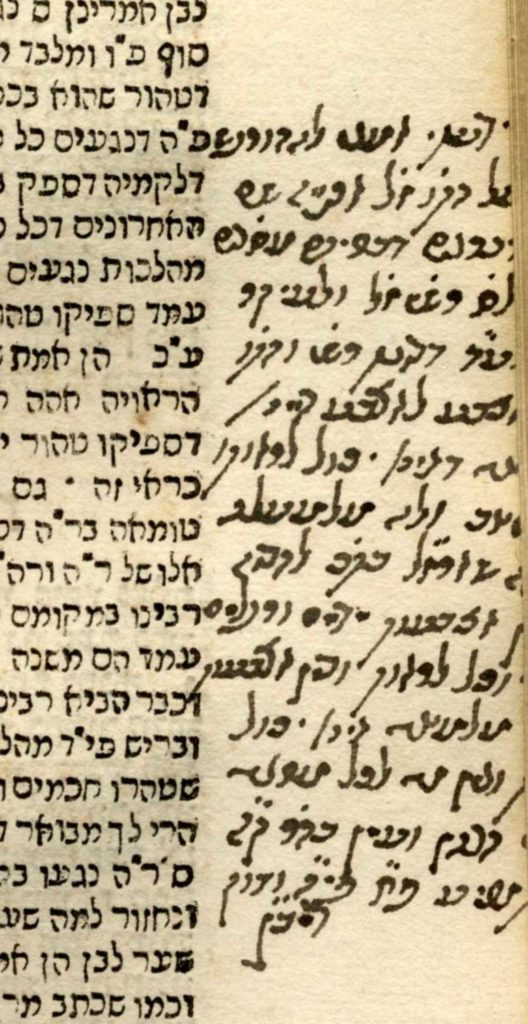
Novellae and in-depth studies on the Rambam’s Mishneh Torah, by Rabbi Yehuda Rosanes of Constantinople. With important handwritten glosses. Constantinople 1731.
Specifications: [3], 2-27, 80, 112, 46, 89 leaves, without the index leaves which were printed a year later and only added to some of the copies. 30 cm. First edition.
Background: The book ‘Mishneh LaMelech’ earned its place in the talmudic literature as one of the basic scholarly books, delving deeply into the words of the Rambam. The author was one of the great scholars of Constantinople of his generation, and the Sephardi sages admired and revered him to the extent that they referred to him as “Rabbi Tana.”
Unique Features: Throughout the book’s pages, there are some thirty glosses in Sephardi handwriting, most of them slightly cut off and signed with the initials: Yavi”n.
The signature of Rabbi Aryeh Leib Hershler is on the title page and the leaf before it. He was a dayan and Av Beit Din in Jerusalem [for information about him refer to: Toldot Chachmei Yerushalayim part 3 page 253], with several glosses in Ashkenazi handwriting, most likely the handwriting of the aforementioned Aryeh Leib.
Condition: Fine. The book’s leaves are in very fine condition with the exception of reinforcements on the first two and last two leaves (the reinforcements are primarily in the white margins). Simple, blemished binding.
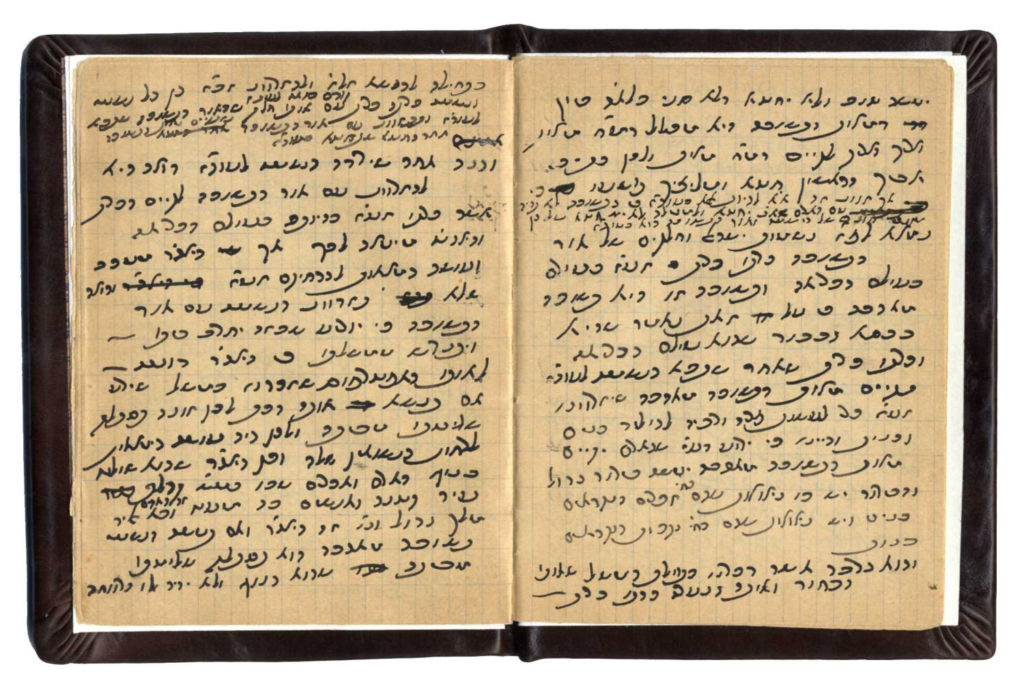
Sermon in the handwriting of the “Ben Ish Chai” regarding repentance stemming from fear of G-d and repentance stemming from love.
Specifications: [24] pages, paper. 13×10 cm. Characteristic Sephardic handwriting with erasures and corrections. About 18-22 lines on a page.
Background: Rabbi Yosef Chaim of Baghdad (1833-1909) was the author of the Ben Ish Chai and the leading Sephardic sage in his time. His father was Rabbi Eliyahu Chaim ben Rabbi Moshe Chaim, rabbi of Baghdad. He was a disciple of Rabbeinu Abdallah Somech, and was known already in his youth for his genius and righteousness. He began sermonizing in the Great Synagogue when he was only 26-years-old and continued giving Shabbat and holiday sermons for about fifty years. Thousands of people gathered to hear his unique four-to-five hour sermons. His fame for his expertise in the hidden and revealed Torah reached all corners of the world and he was noted for his sanctity. In 1869, he travelled to Eretz Yisrael to pray at the graves of the righteous people buried there. It was then Divinely revealed to him that he stemmed from the root of the soul of Binyahu ben Yehoyada, and the titles of many of his works relate to this information as such: Ben Ish Chai, Ben Ish Chayil, Ben Yehoyada, Rav Pe’alim, Od Yosef Chaim and more.
Condition: Very fine. New, magnificent leather binding within a slipcase. Minimal stains.
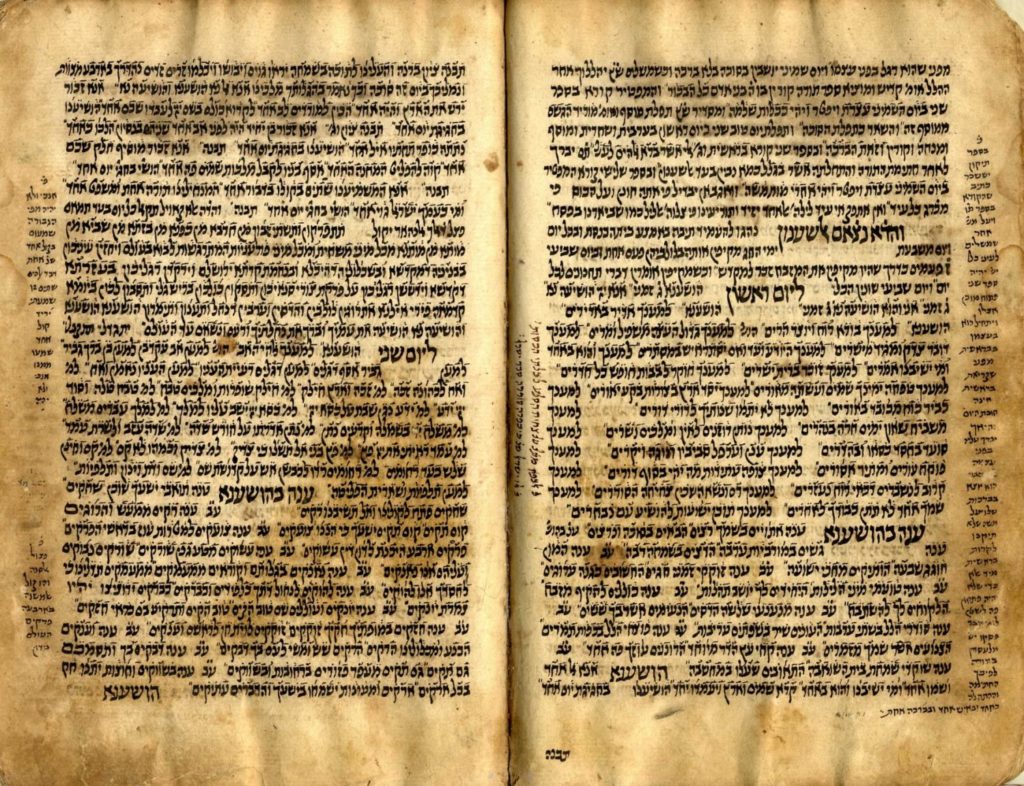
Prayer book for the entire year per the Yemenite customs, including holidays, in the handwriting of kabbalist Rabbi Shalom Hagaji [1652].
Specifications: 75 large leaves. 29 cm. Beautiful script, with marginal comments.
Content: Includes the Passover haggada with marginal comments, Ethics of the Fathers, Scroll of Lamentations with vowelization and the Yemenite mesorah.
Unique features: The vowelization is superlinear – above the letters, and there are significant, unknown variations to the text. Interesting detailed colophon at the conclusion: “Finished with Divine assistance on Wednesday the 19th day of Adar….1652 ….in Migdala Chekel…Shalom son of Dov son of Yitzchak son of Shlomo son of Yaakov AlHagaji, May G-d give me the merit of infinitely increasing books and to be amongst those who give merit to many, and I wrote this prayer book in thirteen days.” (That is, that he wrote the present prayer book in thirteen days)
Background: Rabbi Shalom Hagaji was a prolific scribe in the 17th century. He lived in the “Migdala Chekel” settlement in southwestern Sana’a. His comments, including kabbalisitc comments, appear in the margins of the prayer book. Rabbi Dr. Moshe Gavra, prominent expert of Yemenite manuscripts, states that this is an exceptionally rare, significant copy of the Tiklal. Refer to Encyclopedia L’Chachmei Teiman, p. 136.
Condition: Fine. Stains, worn and a few marginal tears in a few leaves. A few of the side comments are faded. Magnificent leather binding.
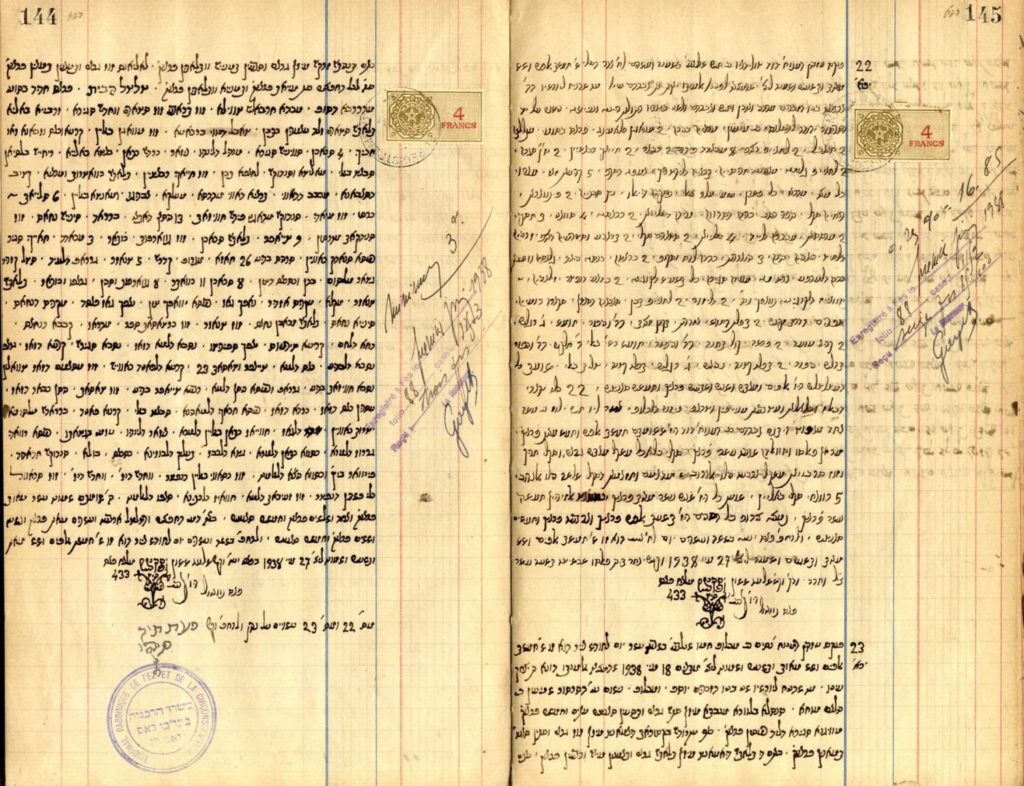
An extremely valuable historical ledger, a remnant of the glory days of the ancient Fez community, home of the great Talmudic decider, Rabbi Yitzchak al-Fasi. Early 20th century.
Specifications: Size of the ledger – 19×30 cm. 200 pages, of which 61 leaves are inscribed.
Unique Features: A special ledger in which the Beit Din recorded the wills drawn up and authorized by them, a list of the estates and the manner of their division among the heirs. All written and signed by the rabbis and dayans of Fez and confirmed in their handwriting, with governmental tax stamps added .
Rabbi Vidal Serfaty, Rabbi of Fez, wrote in his handwriting at the beginning of the ledger: “The estate ledger was opened for writing on the third of Av 5680 [July 18, 1920] in Fez, HaTzvi Vidal Serfaty S.T.” With his stamp in French.
Among the rabbis who wrote and signed: the above Rabbi Vidal Serfaty, Rabbi Moshe ibn Danan, the Av Beit Din Rabbi Matityahu Sirusi, Rabbi Abba Attiah, Rabbi Yosef HaCohen Skali, Rabbi Yosef ben Naim author of Malchei Rabbanan , Rabbi Shlomo Sasson, Rabbi Shmuel ibn Danan, Rabbi Yaakov ibn Danan, Rabbi Yehuda ibn Atar.
Background: For biographical information on the above Rabbis, refer to Malchei Rabbanan by Rabbi Yosef ben Naim part two, Paris 2010 pages 601-611.
Condition: Fine-very fine. Original scuffed binding.
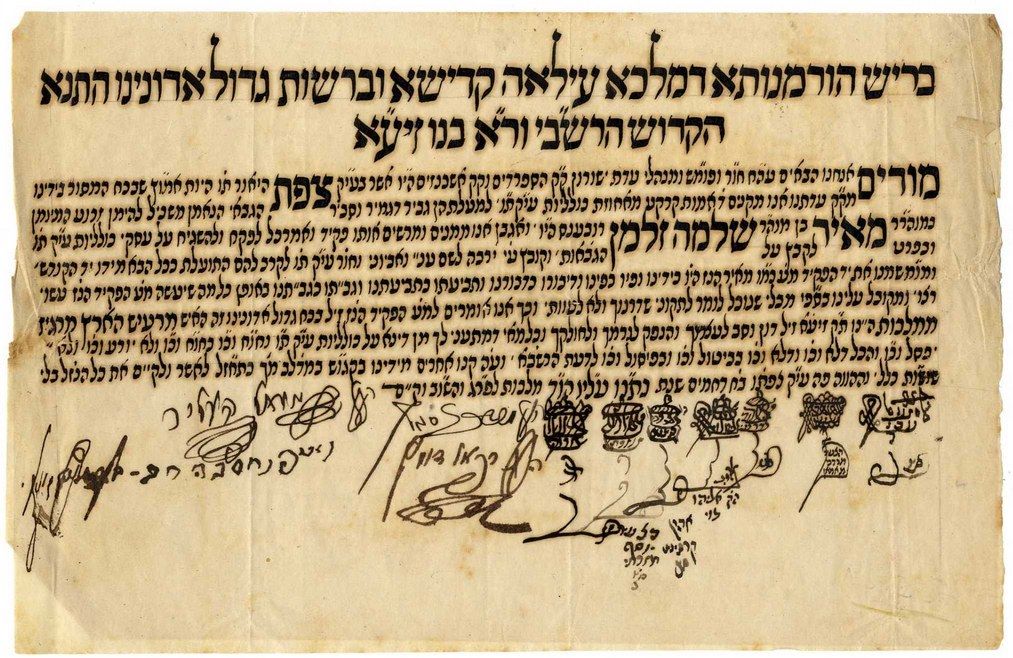
“We …and the administrators of the Adat Yeshurun…we appoint him as a Pakid and Amracal to supervise the transactions of the kollels…the loyal trustee…particularly to oversee the funds…for the poor and poverty stricken…”
Specifications: [1] leaf, paper. 13×21 cm. Scribal handwriting and [12] signatures of the Rabbis of Safed, including Rabbi Shmuel Akko, Rabbi Aharon Kersineti, Rabbi Yosef Mizrachi, Rabbi Shmuel Heller and Rabbi Refael Zilberman. All the signatures – other than one – are legible and identifiable.
Unique features: This is a joint appointment by all Safed kollels, Ashkenazim and Sephardim, bestowed upon Rabbi Meir Rubens, from the committee of Pekidei V’Amraclei Eretz Yisrael in Amsterdam, to represent them in the entire process of collecting and distributing charity funds, to all the city’s needy and sages, both Ashkenazic and Sephardic.
Background: Rabbi Meir son of Shlomo Zalman Rubens was the president of the Vaad Pekidi V’Amraclei Eretz Yisrael in Amsterdam. “He was a honorable person…elevated and lofty, the president of the Pekidim V’Amraclim…Amsterdam…he excelled in his good, pure heart for everything holy and he dedicated his heart and soul to everything related to charity. Above all, charity for Eretz Yisrael was stamped in his heart…and his goals were holy and dedicated to those who sat before Hashem in the courts of Zion…..and he with each act of charity he distributed without differentiating between Ashkenazim and Sephardim…when he was old…he still did not rest, and his hands were completely filled with work, the entire day….he spent little time on his personal affairs but turned his heart to the Divine will, to increase and honor Torah and to increase charitable activities. Above all, to increase the honor of the Vaad HaPekidim V’Amraclim for the benefit of Eretz Yisrael…, to which work he never said “enough.” (From Misped Yerushalayim , two eulogies upon the death of R’ Meir ben R’ Shlomo Rubens ztz”l…Jersualem 1909.)
Rabbi Rubens’ previous appointment as Pakid and Amracal of the holy cities occurred when his father passed away in 1857. It was published in the Ot Emet, s ection five, under the title “eight contracts sent by all the kollels…in the holy city of Jerusalem, Safed, Hebron, Tiberias…Acharai Mot…Shlomo Zalman Rubens…next to three of my dear friends…Meir Rubens, Yonatan Levi Goldmitsan and Yosef Keizer…and these are the names of those who will be called Pekidim V’Amrcalim of the holy city, those who live in the praiseworthy city, Amsterdam.”
Condition: Minimal, light aging-stains, Lightly worn in the margins, not affecting text. Very fine condition.
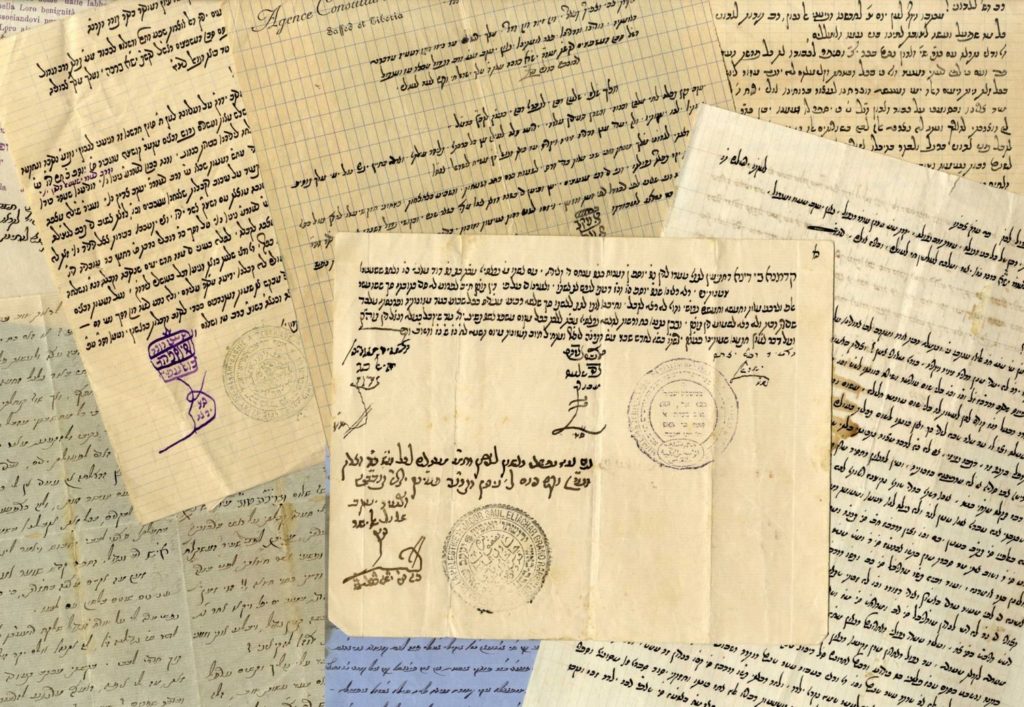
An archive containing over thirty documents, including letters sent by Rabbi Yaakov Elyashar, and letters which he received from rabbis. Most of the documents are from the years 1893-1903.
Unique Features: The archive contains a halachic ruling with his signature, letters sent to him by rabbis of various places, including Rabbi Avraham Palagi of Izmir, Rabbi Yishmael HaCohen of Safed, Rabbi Yosef David Abulafia of Safed, Rabbi Rachamim Yosef Franko of Hebron, letters from Constantinople, Bombay and more.
Among the documents in the archive:
* A letter to the donors of the Beit Va’ad HaKlali in Jerusalem, printed on official paper of the Chief Rabbi of the Land of Israel (Rabbi Yaakov Shaul Elyashar) with his stamp. Written in three languages: Arabic, French and Ladino, with the printed signatures of the rabbis of Jerusalem and the clerks of the Beit HaVaad HaKlali, with the additional stamp of Rabbi Elyashar Chacham Bashi, and the stamp of the Kollelot Va’ad HaSepharadim in Jerusalem.
* A halachic ruling from the year 1895, signed by Rafael Yitzchak Yisrael, Avraham son of Rabbi Shlomo Mevurach, Moreinu Daniel… followed by two lines in Rabbi Elyashar’s handwriting, with his handwritten signature and his stamp.
* A letter to Rabbi Elyashar from Rabbi Yosef Maman of Tiberias, Pesach Sheni, 1900, in his handwriting and two of his calligraphic signatures. At the bottom of the letter are two lines in the handwriting and with the signature of Rabbi Moshe Aharon Yedid. Enclosed is the envelope which was sent with the handwriting and signature of Rabbi Yedid with extensive praise of Rabbi Elyashar.
* A letter from Rabbi Chizkiya Shabtai, Jaffa, 1900. Official paper, his handwriting and his handwritten signature, with the original envelope, with the handwriting of Rabbi Elyashar. Rabbi Chizkiya Shabtai, ‘Chacham Bashi in Jaffa,’ wrote the book Divrei Chizkiya .
* A letter from Rabbi Avraham Palagi to Rabbi Elyashar. 1893. Appears to be entirely in his handwriting. With his handwritten signature and his stamp. Rabbi Avraham Palagi, son of Rabbi Chaim Palagi, succeeded his father as chief rabbi of Izmir, and also wrote many books: Pada et Avraham , Berech et Avraham , Shemo Avraham , VaYosef Avraham , V’Hochiach Avraham and more. It is rare to find letters from him, especially with his signature.
* A letter from Rabbi Yosef David Abulafia of Tiberias, to Rabbi Yaakov Shaul Elyashar. [1895?] with his handwritten signature and stamp. Rabbi Yosef David Abulafia was born in Sofia. He was one of the scholars of Damascus. He immigrated to Tiberias where he served as rabbi from 1883, and died in 1898.
* A letter from Rabbi Yishmael HaCohen to Rabbi Elyashar. 1893. A long letter entirely of Torah thoughts which Rabbi Yishmael HaCohen of Safed sent to Rabbi Elyashar, appears to be entirely in his handwriting, and with his handwritten signature. Rabbi Yishmael HaCohen was born in Persia and was the chief rabbi of Safed. In a responsum, he mentions a halachic booklet sent to him by Rabbi Yisa Bracha, in the book Yisa I”sh by Rabbi Elyashar (Even HaEzer, 15), there is an exchange of letters between the two Rabbis. The letter before us is not printed there.
* A letter from Rabbi Rachamim Yosef Franko of Hebron to Rabbi Yaakov Shaul Elyashar, 1900. A letter in his handwriting and with his signature and stamp with the original envelope. Rabbi Rachamim Yosef Franko (known as the Charif), was appointed as rabbi of the Sephardi congregation of Hebron in 1878.
* A letter from Rabbi Rachamim Yosef Franko of Hebron to Rabbi Yaakov Shaul Elyashar. A letter in his handwriting with his signature and his stamp with the original envelope. A letter full of blessings sent in response to a letter which Rabbi Elyashar sent to him. The letter mentions the wicked man Pinchas, may his name and memory be wiped out, who spoke publicly about the libel… and the Pasha heard, and the rabbi wonders why actions are not being taken to expel him.
Background: Rabbi Yaakov Shaul Elyashar, known by the moniker the ‘Yisa Bracha’ was born in Safed in 1817, orphaned at a young age, and settled in Jerusalem. In 1853, he was ordained as a dayan and served in this capacity until his appointment as the Rishon L’Zion. In 1855 he was sent by the rabbis of Jerusalem as an emissary to Alexandria, Egypt, to attempt to cancel the Jewish community’s decision not to accept emissaries from Jerusalem. Following the success of his mission, he was asked to serve as the rabbi of the city’s congregation, but refused. He began to serve as Av Beit Din of Jerusalem in 1869.
In 1880, he passed up an offer to serve as the Rishon L’Zion in favor of his in-law, Rabbi Rafael Meir Panigel. Following Rabbi Panigel’s death, he was appointed in 1893 as the Rishon L’Zion, in a ceremony which took place in the synagogue in the name of Rabban Yochanan Ben Zakai in Jerusalem. He served in this role for 13 years until his death. In 1889, he headed the representatives of the Old Yishuv of Jerusalem who greeted the German Kaiser Wilhelm II, together with Rabbi Shmuel Salant and Rabbi Eliyahu Mani, and even received an award from him. He died in 1906. He wrote many books with his initials I”sh in the titles: Shenacha L’I”sh , Ma’aseh I”sh , Derech I”sh , Olat I”sh , Sha’al HaI”sh , Kavod L’I”sh , and Pnei I”sh . The Givat Shaul neighborhood of Jerusalem is named after him.
Condition: Sizes and conditions vary. Fine overall condition.
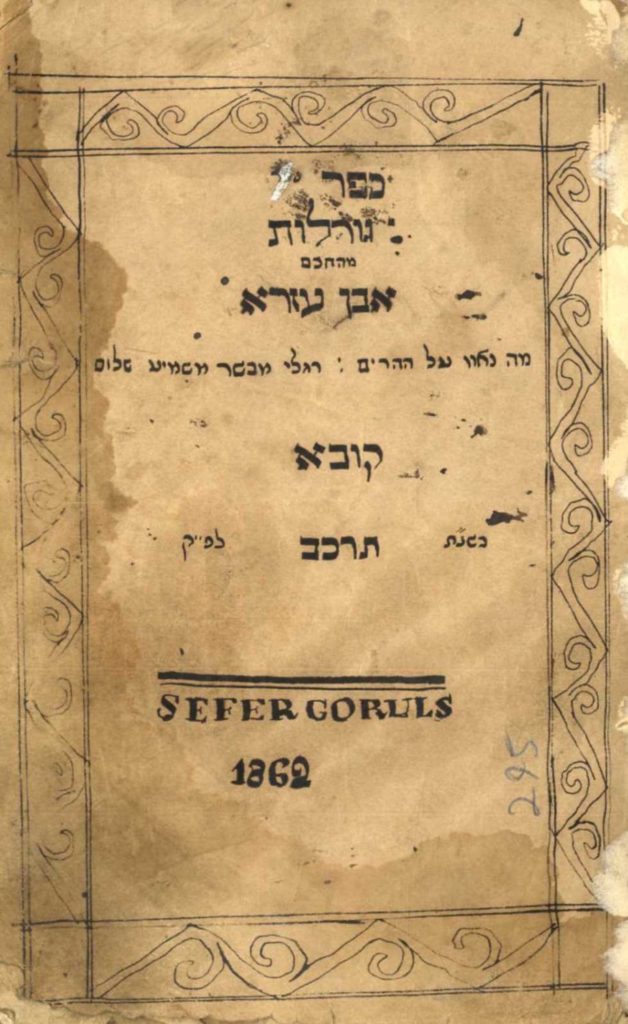
Manuscript, Sefer Goralot Mei’Hachacham Ibn Ezra. Kuba [currently in Azerbaijan], 1862.
Specifications: [92] pages, with 80 pages of written text.
Content: The manuscript includes the “Mazal Choli” with instructions for curing diseases; achieving health goals; arousing hatred between man and wife; love; how to ascertain what a wife will do when she is far away, and more. Quotes an anecdote about Rabbi Matya ben Cheresh, medrashei psukim, Goralot Achitofel, and the “mazal choli l’Chizkiyahu HaMalech.” The leaf after the title page features a table with aleph-beit letters for 1-42, undereath them is the text אני קטן המעתיקים רב”א ס”ט בשביל יצחק בר שמחה. At the end of the 42 clauses is the text: תם ונשלם ש ב ח לאל בורא עולם.
This concluding text is followed by a number of blank pages which is then followed by a table with the “Ana Bikoach” prayer in a chart, and the text…”Whomever shall come to ask, before asking should recite ‘Hashem is my portion….You support my lot…’and should place his hand on a word and it will be his question.” This opens to an index according to the order of words in the “Ana Bikoach” prayer, through the word “גמלם.” Next to each word there is an answer for the questioner who placed his hand on that word in the chart.
Condition: Moderate-fine. Stains, number of detached leaves, two leaves are stuck closed, a few leaves are worn at their edges, the spine is partially broken.